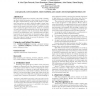Free Online Productivity Tools
i2Speak
i2Symbol
i2OCR
iTex2Img
iWeb2Print
iWeb2Shot
i2Type
iPdf2Split
iPdf2Merge
i2Bopomofo
i2Arabic
i2Style
i2Image
i2PDF
iLatex2Rtf
Sci2ools
103
Voted
ATAL
2007
Springer
2007
Springer
Real-time agent characterization and prediction
Reasoning about agents that we observe in the world is challenging. Our available information is often limited to observations of the agent’s external behavior in the past and present. To understand these actions, we need to deduce the agent’s internal state, which includes not only rational elements (such as intentions and plans), but also emotive ones (such as fear). In addition, we often want to predict the agent’s future actions, which are constrained not only by these inward characteristics, but also by the dynamics of the agent’s interaction with its environment. BEE (Behavior Evolution and Extrapolation) uses a faster-than-real-time agentbased model of the environment to characterize agents’ internal state by evolution against observed behavior, and then predict their future behavior, taking into account the dynamics of their interaction with the environment. Categories and Subject Descriptors I.2.6 [Artificial Intelligence]: Learning – parameter learning. I.2.11 [A...
Related Content
| Added | 07 Jun 2010 |
| Updated | 07 Jun 2010 |
| Type | Conference |
| Year | 2007 |
| Where | ATAL |
| Authors | H. Van Dyke Parunak, Sven Brueckner, Robert S. Matthews, John A. Sauter, Steve Brophy |
Comments (0)

